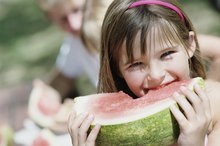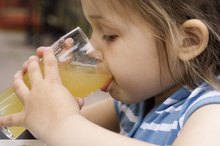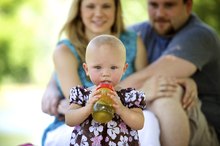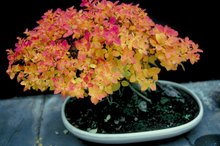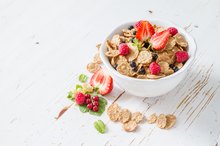Are Pears Good for Constipation in Infants?
You may notice your infant is becoming constipated by the frequency and manner of how his stools are passed. If your infant is straining to have a bowel movement, having them once or less per day or is passing hard and small stools, he may be constipated. Constipation can be painful for your little one 2. Certain foods, including pears, may help relieve your child's constipation. Speak to your pediatrician if you believe your baby is constipated.
Causes o Constipation
Constipation is an effect of food waste moving too slowly through the digestive system. Your intestinal muscles contract to move the waste through and eventually to excretion. Weak muscles or a small, dry stool can cause a malfunction in this system. A longer time in the digestive tract also increases the water that is absorbed in the feces leading to an even drier and harder stool.
- Constipation is an effect of food waste moving too slowly through the digestive system.
- Weak muscles or a small, dry stool can cause a malfunction in this system.
Pears for Constipation
What to Feed a One-Year-Old for Constipation
Learn More
A natural remedy for constipation in infants in the consumption of pears. Pears or pear juice can be a useful in preventing or reducing constipation, according to the American Academy of Pediatrics at HealthyChildren.org 2. The website explains that for infants, pear juice contains a lot of sugar that is not easily digested, so it draws fluid into the digestive tract and helps loosen stools. Pear juice should not be given to an infant before 1 month of age. Seattle Children's Hospital Research Foundation recommends that you should only give an infant 1 ounce of juice per month of age per day 3. For example, a 3-month old infant should not have more than 3 ounces of fruit juice per day.
Fiber in Pears
Pears are high in fiber which may also account for their help in preventing and treating constipation. A lack of fiber in your child's diet may lead to constipation, according to Dr.Sears.com 1. Dietary fiber helps to add bulk and water to your stool, making it easier for your digestive system to move it through the digestive tract.One medium sized pear with the skin-on can provide 5.5 grams of fiber, while one 4-ounce jar of babyfood pears contains 4.1 grams of fiber. There is no set recommendation on fiber intake for infants up to 1 year of age. Speak to your pediatrician about the amount your baby should be eating.
- Pears are high in fiber which may also account for their help in preventing and treating constipation.
- Dietary fiber helps to add bulk and water to your stool, making it easier for your digestive system to move it through the digestive tract.
Serving Size
A High-Fiber Diet for Children With Constipation
Learn More
Offer your child a serving of pear juice in addition to her usual daily feedings. Between 2 to 4 ounces of pear juice per day can help stop her constipation. Also try adding pears into her daily eating plan. Pears make a healthy snack or accompaniment to breakfast, lunch or dinner. Consult your pediatrician for the right approach to treat your child's constipation.
- Offer your child a serving of pear juice in addition to her usual daily feedings.
- Also try adding pears into her daily eating plan.
Related Articles
References
- Dr. Sears.com; Constipation; Dr. Sears and Martha Sears, R.N.
- HealthyChildren.org: Infant Constipation
- Nutrition: Concepts and Controversies; Frances Sizer, et al.
- Reiland H, Slavin J. Systematic review of pears and health. Nutr Today. 2015;50(6):301-305. doi:10.1097/NT.0000000000000112
- Pears, raw. FoodData Central. U.S. Department of Agriculture. Published April 1, 2019.
- Soliman GA. Dietary fiber, atherosclerosis, and cardiovascular disease. Nutrients. 2019;11(5):1155. doi:10.3390/nu11051155
- Atkinson FS, Foster-Powell K, Brand-Miller JC. International Tables of Glycemic Index and Glycemic Load Values: 2008. Diabetes Care. 2008;31(12):2281-2283. doi:10.2337/dc08-1239.
- Dietary Reference Intakes (DRIs): Recommended Dietary Allowances and Adequate Intakes, Elements. National Institutes of Health, Food and Nutrition Board. Updated 2011.
- Desai V, Kaler SG. Role of copper in human neurological disorders. Am J Clin Nutr. 2008;88(3):855S-8S. doi:10.1093/ajcn/88.3.855S
- Stone MS, Martyn L, Weaver CM. Potassium intake, bioavailability, hypertension, and glucose control. Nutrients. 2016;8(7):444. doi:10.3390/nu8070444
- Carr AC, Maggini S. Vitamin C and immune function. Nutrients. 2017;9(11):1211. doi:10.3390/nu9111211
- Wedick NM, Pan A, Cassidy A et al. Dietary flavonoid intakes and risk of type 2 diabetes in US men and women. Am J Clin Nutr. 2012;95(4):925-33. doi:10.3945/ajcn.111.028894
- Larsson SC, Virtamo J, Wolk A. Total and specific fruit and vegetable consumption and risk of stroke: A prospective study. Atherosclerosis. 2013;227(1):147-52. doi:10.1016/j.atherosclerosis.2012.12.022
- Hu D, Huang J, Wang Y, Zhang D, Qu Y. Fruits and vegetables consumption and risk of stroke: A meta-analysis of prospective cohort studies. Stroke. 2014;45(6):1613-9. doi:10.1161/strokeaha.114.004836
- Anderson JW, Baird P, Davis RH, et al. Health benefits of dietary fiber. Nutr Rev. 2009;67(4):188-205. doi:10.1111/j.1753-4887.2009.00189.x
- Lee HS, Isse T, Kawamoto T, Baik HW, Park JY, Yang M. Effect of Korean pear (Pyruspyrifolia cv. Shingo) juice on hangover severity following alcohol consumption. Food Chem Toxicol. 2013;58:101-6. doi:10.1016/j.fct.2013.04.007
- Oral Allergy Syndrome (OAS) or Pollen Fruit Syndrome (PFS). American Academy of Allergy Asthma & Immunology.
- Dirty Dozen: EWG's 2019 Shopper's Guide to Pesticides in Produce. Environmental Working Group. Updated 2019.
- Pears, asian, raw. FoodData Central. U.S. Department of Agriculture. Published April 1, 2019.
Writer Bio
Laura Niedziocha began her writing career in 2007. She has contributed material to the Stoneking Physical Therapy and Wellness Center in Lambertville, N.J., and her work has appeared in various online publications. Niedziocha graduated from Temple University with a Bachelor of Science in exercise science. She also has her Associate of Arts in communications from the Community College of Philadelphia.

